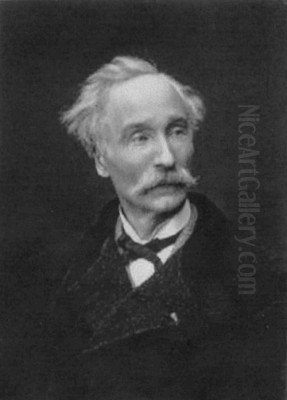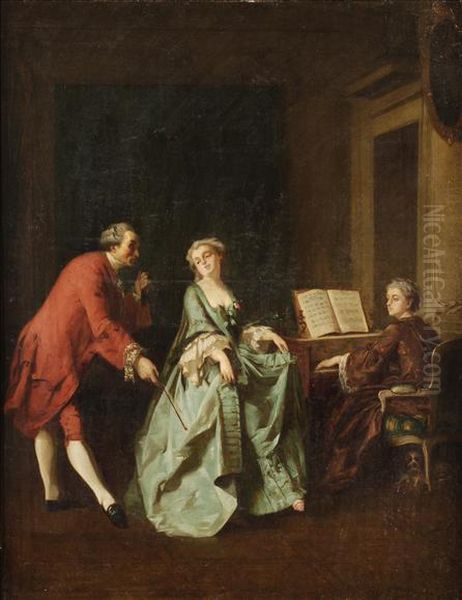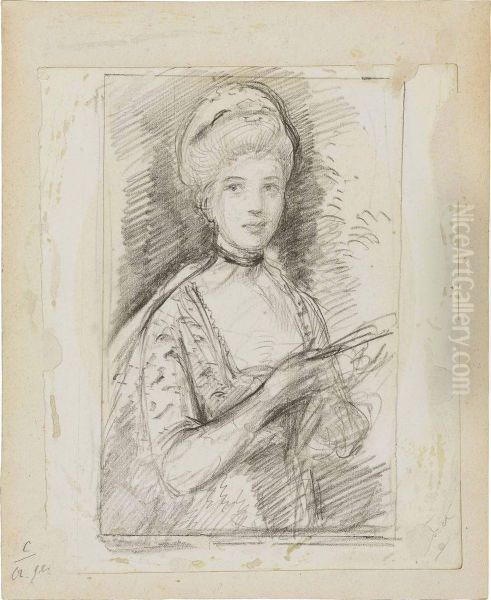
Joseph Caraud stands as a distinctive figure in nineteenth-century French art. Born in Cluny, Saône-et-Loire, on January 5, 1821, and passing away in Paris on July 18, 1905, his long career spanned a period of dramatic artistic change. While movements like Realism and Impressionism challenged academic norms, Caraud carved a niche for himself, specializing in meticulously rendered genre scenes that often evoked the grace and luxury of the eighteenth century, drawing comparisons to masters of that earlier era.
Early Life and Artistic Formation
Caraud's artistic journey began formally when he entered the École des Beaux-Arts in Paris. There, he studied under notable academic painters Abel de Pujol (1785-1861) and Charles-Louis Lucien Müller (1815-1892). Both teachers were respected figures within the academic tradition, known for historical and religious subjects (Pujol) and large-scale historical scenes (Müller). This training provided Caraud with a strong foundation in drawing, composition, and traditional painting techniques, which would underpin his later detailed style. His official debut at the prestigious Paris Salon occurred in 1843, initially presenting portraits.
Italian and Algerian Influences
Travel played a significant role in shaping Caraud's thematic interests. Early journeys to Italy exposed him to the richness of its art and culture. Starting around 1848, he began focusing on subjects inspired by Italian life, often depicting charming genre scenes. Works like Young Italian Girl at the Fountain (1848) and Italian Offering Jewels to a Young Girl (1848) exemplify this period, showcasing his burgeoning interest in narrative detail and costume.
A subsequent trip to Algeria in 1853 proved equally influential, steering him towards Orientalist themes. This was a popular genre in nineteenth-century France, fueled by colonial expansion and a European fascination with the cultures of North Africa and the Middle East. Artists like Eugène Delacroix (1798-1863) and later Jean-Léon Gérôme (1824-1904) famously explored these subjects. Caraud contributed works such as Interior of a Moorish House in Algiers (1853) and Algerian Woman Teasing a Parakeet, capturing exotic settings and figures with the same attention to detail seen in his European subjects, albeit filtered through a romanticized European lens typical of the era's Orientalism.
The Signature Style: Echoes of the Ancien Régime

Despite his excursions into Italian and Orientalist themes, Caraud became most renowned for his depictions of elegant social life, often set in the eighteenth century or strongly evoking its aesthetic. His style consciously looked back to the Rococo period, drawing inspiration from the delicate brushwork, lighthearted subjects, and refined atmosphere found in the works of Antoine Watteau (1684-1721), Jean-Honoré Fragonard (1732-1806), and Jean-Baptiste Greuze (1725-1805). It is crucial to note that this was a stylistic affinity, not based on direct personal interaction, as these masters belonged to a much earlier generation.
Caraud excelled in rendering luxurious fabrics – silks, satins, lace – and the intricate details of period furniture and interiors. His paintings often feature graceful women in elaborate gowns engaged in leisurely pursuits: reading letters, playing music, arranging flowers, or participating in quiet courtship rituals. He employed a refined technique, often using warm color palettes and transparent glazes to achieve a luminous, polished finish. His handling of light was subtle, typically focusing on interior scenes illuminated softly, enhancing the intimate and opulent mood.
This focus on idealized beauty, historical nostalgia, and meticulous craftsmanship set Caraud apart from the burgeoning Realist movement, led by artists like Gustave Courbet (1819-1877) and Jean-François Millet (1814-1875), who concentrated on depicting the unvarnished realities of contemporary peasant and working-class life. Caraud's art offered an escape into a more refined, albeit imagined, past.
Representative Works and Themes
Caraud's oeuvre is characterized by charming, anecdotal scenes. Beyond his early Italian pieces and Algerian subjects, his mature work frequently revisited eighteenth-century settings. Titles often reflect the narrative simplicity and focus on gentle social interactions: The Love Letter, The Music Lesson, Preparing for the Ball, A Visit to the Studio. These paintings capture moments of quiet elegance and refined sentiment.
His skill in depicting textures and details was paramount. Whether rendering the sheen on a silk dress, the carving on a Louis XV chair, or the delicate features of his subjects, Caraud demonstrated remarkable precision. This meticulousness appealed greatly to the tastes of the bourgeoisie and aristocracy during the Second Empire and early Third Republic, who appreciated the craftsmanship and the nostalgic vision of aristocratic grace.
His work shares some common ground with other academic painters of the era who specialized in historical genre scenes, sometimes referred to as "troubadour style" painting in its earlier iterations, which romanticized the Middle Ages and Renaissance. While Caraud focused more on the 18th century, the underlying appeal of historical settings and detailed execution connects him to contemporaries like Ernest Meissonier (1815-1891), known for his incredibly detailed small-scale historical and military scenes, or even the highly polished academic nudes and mythological scenes of William-Adolphe Bouguereau (1825-1905).
Recognition and Popularity

Caraud achieved considerable success during his lifetime. He exhibited regularly at the Paris Salon for decades, from his debut in 1843 until his final participation in 1902. His works were well-received by critics and the public alike, appreciated for their technical skill and charming subject matter.
This popularity led to official recognition. In 1867, he was awarded the Chevalier de la Légion d'honneur (Knight of the Legion of Honour), a significant mark of distinction in France. He also received accolades at international exhibitions, including a medal (likely Bronze, though some sources mention Gold, Bronze is more commonly cited) at the Exposition Universelle (World's Fair) held in Paris in 1889.
The widespread appeal of Caraud's paintings is further evidenced by the fact that many were reproduced as engravings and prints. This allowed his images to reach a broader audience beyond the collectors who purchased the original canvases, making his vision of eighteenth-century elegance a familiar part of popular visual culture in the late nineteenth century. His works entered numerous private collections and can be found today in museums in France and internationally.
Context within Nineteenth-Century Art
Caraud's career unfolded against a backdrop of intense artistic innovation and debate. While he remained largely faithful to academic techniques and traditional notions of beauty, the art world around him was being transformed. The Realism of Courbet challenged idealized subject matter. The Barbizon School painters, like Théodore Rousseau (1812-1867), focused on landscape painting outdoors.
Most dramatically, the Impressionist movement emerged in the 1870s, with artists like Claude Monet (1840-1926), Pierre-Auguste Renoir (1841-1919), and Edgar Degas (1834-1917) revolutionizing painting with their focus on capturing fleeting moments, the effects of light, and contemporary life, using broken brushwork and brighter palettes. Compared to the Impressionists' radical approach, Caraud's work appeared conservative, maintaining smooth finishes, detailed rendering, and historical subject matter.
Yet, Caraud was not alone in pursuing a path distinct from the avant-garde. Academic painting, represented by figures like Gérôme, Bouguereau, and Alexandre Cabanel (1823-1889), continued to dominate the official Salon and enjoy immense popularity and patronage throughout much of the century. Caraud's specific niche – the Rococo revival genre scene – placed him within this broader academic context, but with a specialized focus that distinguished him. His work catered to a persistent taste for historical romance, elegance, and fine craftsmanship that coexisted alongside the more challenging innovations of Realism and Impressionism.
Later Life and Legacy
Joseph Caraud continued to paint and exhibit into the early twentieth century, remaining committed to his chosen style. His last recorded participation in the Paris Salon was in 1902, just three years before his death in Paris in 1905.
His legacy is that of a highly skilled specialist painter who masterfully recreated the aesthetics of a bygone era. While not an innovator in the mold of the Impressionists, Caraud satisfied a significant market demand for beautifully executed paintings depicting scenes of elegance and historical charm. His work serves as a reminder of the diversity of artistic production in the nineteenth century, where academic traditions and nostalgic genres thrived alongside revolutionary new movements. He remains appreciated for his technical proficiency, his meticulous attention to detail, and his ability to evoke the refined atmosphere of the eighteenth century with grace and charm. His paintings continue to be sought after by collectors interested in academic and genre painting of the period.